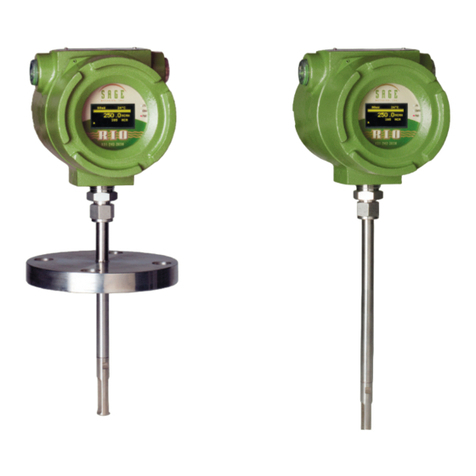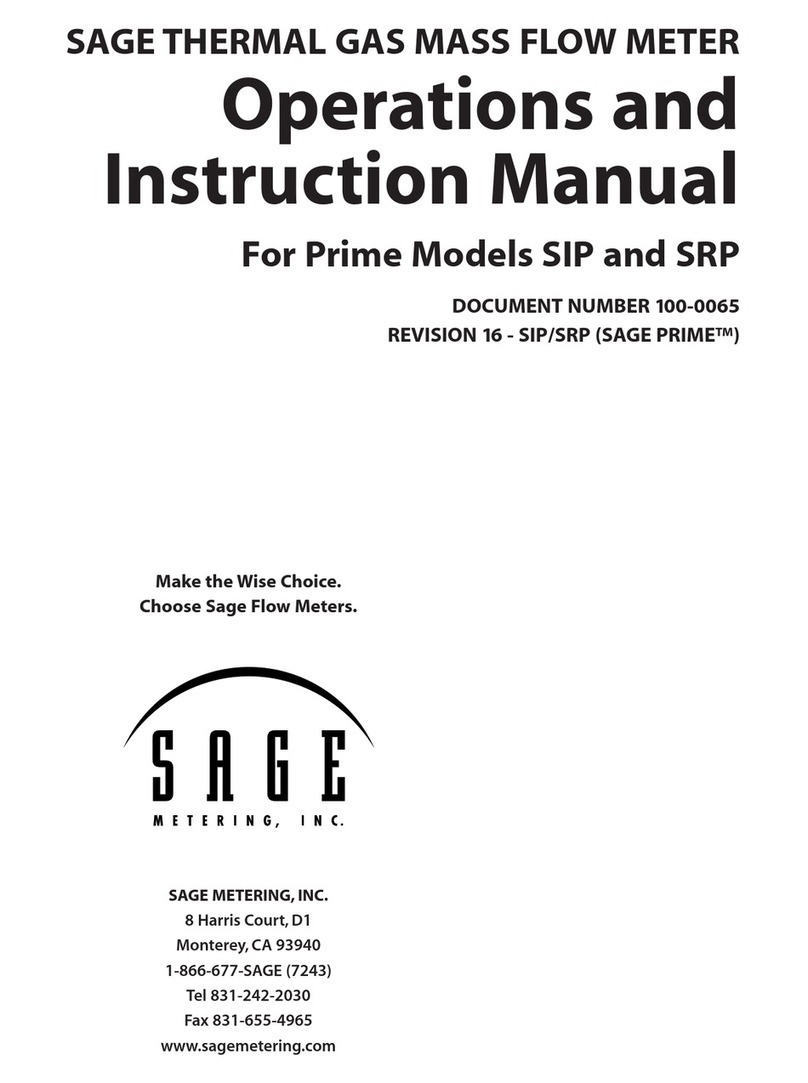
S A G E M E T E R I N G , I N C . O p e r a t i o n s a n d I n s t r u c t i o n M a n u a l
10
INSTALLATION AND MOUNTING
■Check the Certificate of Conformance included
with your Sage Thermal Mass Flow Meter for
system pressure, temperature, gas composition,
power input, and signal output.
■It is recommended that the flow meter be inserted
in a location of maximum straight run. It is sug-
gested that there be a minimum of 15 pipe diame-
ters of straight run upstream, and 5 diameters
downstream, depending on the conditions. See
chart on page 12. Note, obstructions such as
valves, blowers, expanders and PVC and HDPE
pipes will require additional straight run (contact
factory for assistance).
■Check the orientation: Standard calibration flow
direction is left to right when facing the flow
meter. Gas flow direction is marked with an arrow
on in-line flow meters; UPSTREAM is marked on
insertion probes.
■Do not rotate probe, or errors may occur. If enclo-
sure is facing incorrectly, rotate the enclosure 180˚,
but do not rotate the probe. The UPSTREAM mark
still needs to be facing Upstream.
■Hook up the system per the wiring diagram pro-
vided with your Sage flow meter. Double check
that wiring for the proper power and signal con-
nections are correct.
■Check that all plumbing and electrical hook-ups
are in accordance with OSHA, NFPA, and all other
safety requirements.
■For Remote Style Meters (SRG) be sure the
Remote Electronics is matched with the
Transducer’s Junction Box and its attached
Probe or Flow Body. There will be Metal Serial
Number Tags on both the Transducer as well
as the Remote Electronics enclosure. Do not
mismatch the serial numbers of the Remote
Electronics and the Junction Box, or calibration
errors will occur.
LOCATING PROPER WIRING DIAGRAM
1) Look at the sticker on your meter. The first three
digits describe the basic model that you have.
Refer to the appropriate page numbers below for
your wiring diagram
2) SIE: See page 17
3) SRE: See page 17 for input/output terminals;
see page 19 (Junction Box Wiring Terminals
for Remote Style Meters) and page 20 (Circuit
Board Layout for General Purpose Meter)
WIRING O THE SERIES SIE (Integral Style)
1) Loosen Allen Head Socket (using a 1/16" Allen
Key) to remove the tall domed enclosure (the
solid rear portion of the dual enclosure).
2) Unscrew the domed enclosure by rotating counter-
clockwise until it can be removed, exposing the
wiring terminals.
3) If DC Powered, connect as per page 16 after rout-
ing wires through conduit fittings.
4) If AC Powered, see page 17, and first loosen the
Power Cable Plug from its receptacle under the
Transformer.
5) Connect the Power and Earth Ground to termi-
nals noted on page 17 after routing wires through
conduit fittings.
6) Make appropriate connections (4-20ma outputs,
etc.) as per Terminal Hook-Up on page 16 after
routing wires through conduit fittings.
7) Re-insert the AC Power Cable Plug back into its
receptacle (see page 17).
8) Reverse Steps 1 and 2 to seal enclosure.
WIRING O THE SERIES SRE
1) Same as Steps 1 to 8 above, except the Junction
Box (Transducer) needs to be connected.
2) To connect Junction Box refer to page 19, being
sure to first run wires through the conduit
receptacle.
REV. 03-SIE/SRE





























